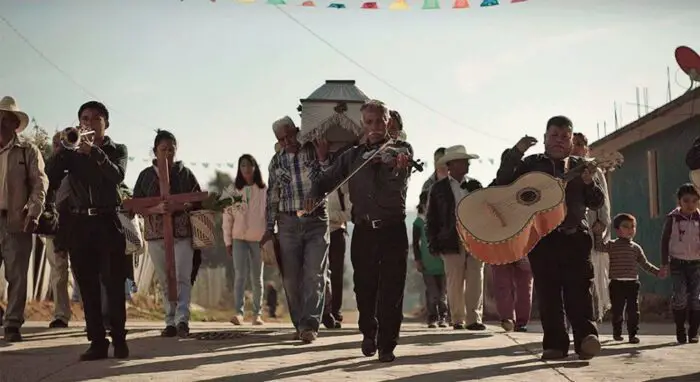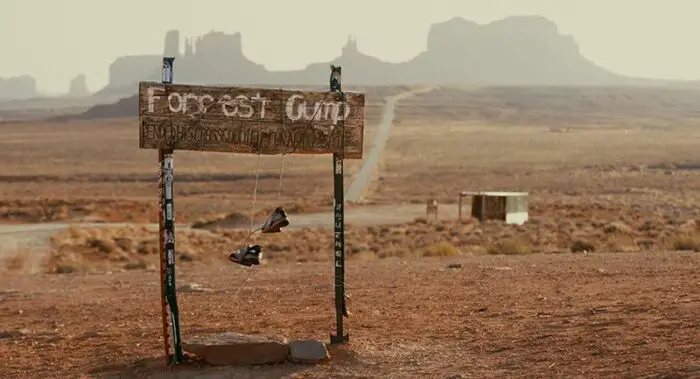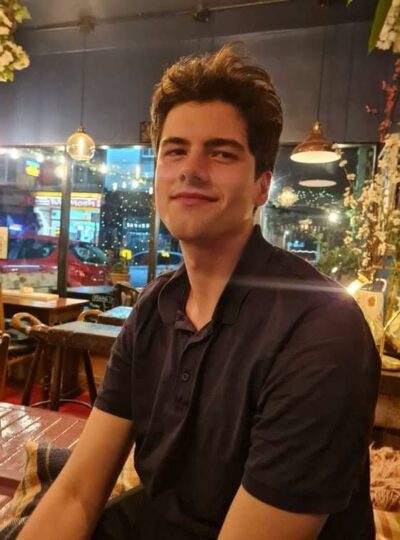Continuing our journey through the releases showcased as part of the London Film Festival, we have a diverse lineup featuring two new releases and a restoration of a lost work of European surrealism. There’s Angeles Cruz’s Mexican triptych of women’s issues Nudo Mixteco; documentarian Alexandre O. Phillippe, director of 76/52 and Memory: The Origins of Alien, turning his gaze to Monument Valley and the films of John Ford in The Taking; and we have a restoration of a silent-era short film believed lost to fascist censorship with Stefan and Franciszka Themerson’s Europa.
Nudo Mixteco
 Nudo Mixteco (dir. Angeles Cruz, 2021)
Nudo Mixteco (dir. Angeles Cruz, 2021)
Structurally and thematically resonant of Kelly Reichardt’s 2016 masterpiece Certain Women—though with sadly little of that film’s resonant grace—Angeles Cruz’s Nudo Mixteco takes us into rural Mexico with a triptych of stories about the women of an indigenous community and the struggles they face from the surrounding patriarchy, contending with neglectful, abusive or unloving family members. In a similar fashion to Reichardt’s film, each story takes place concurrently within the same space, yet they never meaningfully interact, rather just brushing past each other. Each tale follows an individual who has returned to the remote village of San Mateo after years of absence in the nearby city and each of these individuals will find themselves at some point entreating someone from their past to join them and leave the stifling backwater.
The first story follows Maria (Sonia Couch), a young woman returning to attend her mother’s funeral to pay her respects, meeting the cold rejection of her homophobic father but possibly rekindling a relationship with an old lover. Thereafter we meet a possessive and violent husband who returns home to find his wife Chabela (Aida Lopez) has found another man to perform the marital and paternal duties he has been shirking in his absence. The last tale follows Tona (Myriam Bravo), who returns to rescue her estranged young daughter from the clutches of an abusive uncle.
Rarely do these stories become particularly involved. Mostly, they comprise of the slow revelation of a situation, the resolution of which is as undemonstrative as its beginning, offering not a bare second of humour and precious little warmth. The film might have sold itself on an exoticised presentation of Mixtec culture, but what it does depict is underplayed and underexplained, treated as merely an organic part of the community the film is presenting a cross-section of. Perhaps this is an admirable effort of demystification, but the film and its drama rarely catches alight or gets under the viewer’s skin to create an emotional or intellectual effect. It plays out more as an affirmation of the difficulties women face in remote, insular communities, without much enlightenment beyond the basic facts of its crushingly trying scenarios.
The Taking
 The Taking (dir. Alexandre O. Philippe, 2021)
The Taking (dir. Alexandre O. Philippe, 2021)
“What’s the difference between myth and propaganda if they serve the same purpose?”
Following on from his ruminations on classic American horrors like Psycho and Alien, director Alexandre O. Philippe turns his head towards a different genre, the Western, taking Monument Valley and its use on film as the intriguing focal point. Like his past efforts, Philippe casts his net wide over his subject, perhaps a little too wide, though in this instance I can see where this felt like an admirable intention. Besides exploring Monument Valley as a cultural marker for white America, the film also acknowledges that it is a real geographical space with a history of its own, one very much a part of America’s colonial past and present. Looming large over the conversation is, of course, John Ford, who shot seven of his most celebrated films on location in Monument Valley, though the film does include references to many others, including, too briefly for my mind, the film I always think of when I picture Monument Valley: James William Guerico’s cult classic Electra Glide in Blue. You could’ve devoted an entire section to that one.
The film alternates between analysis of the films themselves and how they used the location of the valley to reflect their themes and tell their stories, and the ethics of the historical revisionism and obscuring of indigenous history that the films, however unreflectively, used the valley in ultimate service of. The film points out the exploitation of the Navajo people who lived and still live in the area, from their internment in reservations, use in uranium mines, up to being hired on film sets to make the films through which white America was rewriting their history. Ultimately, this feels less like a comprehensive look at the cultural legacy of Ford and his films and more like one that’s just pulling in two directions. Perhaps a more narrative approach would have helped, front-loading the film with the discussion of the films themselves before leaning into their cultural impact in the second half, but Philippe keeps jumping from one to another throughout the film and it rarely feels as if the two are having much of a dialogue.
As a film aficionado with a liberal outlook, I was fascinated by both sides of the film, with the cultural context a vital reminder that the art we produce and consume has real-world consequences on how people see themselves and others, and the film analysis providing an enthralling exploration of the subtle ways in which the unique landscape of the valley shaped the texts shot and set there. From the stoic monolithic characters standing out against the skyline to the very flatness of the depression staging a fraught underworld sandbox, different generations of filmmakers used the valley to activate the American ideal and mythology in different ways, whether organically as Ford did, or in homage and pastiche as did later filmmakers like Sergio Leone and Guerico. Whenever the analysis risks getting too full of itself though, it’s punctuated by footage of an interview with a fabulously surly Ford hilariously undercutting the intellectualism of the film’s inquiries.
The film does suffer from a lack of focused depth at times, and occasionally it left me wanting, but Philippe is wry and eclectic enough with his choice of clips to give a deft authorial touch to the film, even reusing the Greek acropolis from Memory in ironic homage to the way Ford reused locales within the valley in his films. The film also ends on an unexpected and spontaneous moment of urgency, culminating on a discussion of the changing meaning of iconic spaces in the national identity structured around the January 6th Capitol riots, tarnishing the symbolic inviolability of the Capitol building. Again, the film mightn’t convince with everything it throws into itself, but its infectious enthusiasm and curiosity comes through throughout.
Europa

Europa (dirs. Stefan Themerson & Franciszka Themerson, 1932)
Restored after eight decades and believed to have been lost to Nazi censorship, the polish surrealist short film Europa, modelled after a poem by Anatol Stern, is presented as part of the Festival Treasures collection with an original score by Ludowijk Muns. Directing duo Stefan and Franciszka Themerson provide fairly rote material by the standards of interwar European surrealist satire, symphonically mixing imagery to create associations. As a portrait of Europe once again on the brink of war, the film layers motifs of greed and consumption, with images of knives, cutlery and mechanically masticating jaws.
The central motif of the film comes in the form of a glowing, beating heart, the heart of Europe abraded by the assassination of Archduke Franz Ferdinand, leading to further images of violence, murder and war, as well as crucifixion and nationalist flag-waving. Some of the imagery is blunt and forceful; there are multiple shots of mouths having newspaper forced into them, juxtaposed against more placid images of the innocence and indomitability of nature as roots force their way up through concrete. The heart motif is paired with recurrent images of apples being divided and consumed, fueling the engine of the human mechanism that is Europe.
As a work of surrealism, Europa is even more than usually disjointed in theme and tone, but there’s an enduring force to its brutalism and its themes are undeniably predictive given the great tragedy that befell Europe in the years afterwards and which almost led to its destruction.



